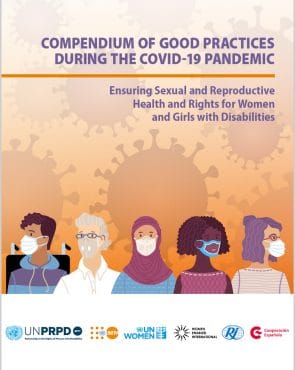Compendium of Good Practices during the COVID-19 Pandemic: Ensuring Sexual and Reproductive Health and Rights for Women and Girls with Disabilities

Compendium of Good Practices during the COVID-19 Pandemic: Ensuring Sexual and Reproductive Health and Rights for Women and Girls with Disabilities
Available in English
Disponible en Espańol
Disponible en Français
As research conducted by UNFPA and Women Enabled International (WEI) in 2020 has revealed, the COVID-19 pandemic has had a profound impact on the rights and wellbeing of women and girls with disabilities.
- Healthcare systems and providers have been overstretched, leading many to reallocate resources and redeploy personnel away from services that women and girls with disabilities need, including SRH services.
- Local clinics providing family planning services and shops providing menstrual hygiene items have closed during the crisis, meaning that everyone in the community must now travel farther to access these goods and services, while mobile clinics were prevented from reaching rural and remote areas due to travel restrictions. This creates an additional burden for persons with disabilities, who must not only identify another accessible family planning clinic but also must locate affordable and physically accessible transportation to access that clinic in another community, a particular challenge in rural and remote communities.
- As a measure to prevent the spread of COVID-19, some clinics and hospitals have implemented rules that limit the number of people who can accompany any person, including persons with disabilities, into those hospitals and clinics. This has had the effect of denying persons with disabilities access to support persons, personal assistants, and sign language interpreters in these settings, thereby limiting their ability to navigate inaccessible environments, meet hygiene needs, or communicate with healthcare providers. 3
- Changes in the way that healthcare services are delivered—for instance, through telehealth or with personal protective equipment like masks that can limit the ability to lip read—have not always been designed with accessibility for persons with disabilities in mind and have not always taken into account the digital divide experienced by persons with disabilities, particularly women and girls with disabilities.
The good practices outlined in this Compendium come from all regions of the world and represent diverse healthcare systems, cultures, and socioeconomic positions.
This resource aims to aid a range of actors such as United Nations Country teams, civil society, governments, multilateral organizations, and others involved in COVID-19 response and recovery—as well as planning, response, and recovery from other crises—to ensure that their practices are inclusive of women and girls with disabilities and ensure their rights
Downloads
DOC format downloads
PDF format downloads
- No files found
DOC format downloads
- No files found
PDF format downloads
- No files found
DOC format downloads
- No files found
PDF format downloads
- No files found
DOC format downloads
PDF format downloads
DOC format downloads
PDF format downloads
- No files found
DOC format downloads
- No files found
PDF format downloads
- No files found
